Home
 Native American Indian tribes lived in the territory of US and Canada long before the conquistadors. They lived in harmony with nature. That's why their culture is closely related with the laws of nature. Native Americans made their garments from animal skins and fur, bark of trees and other materials which they gained hunting and gathering. They used sinew as threads, made jewelry from wood, shells and stones, embellished clothes with beads and patterns on fabric. Native American Indian tribes survived in Alaska and in desert areas, in thick forests and in mountainous regions. They could understand the nature, respect it and use its gifts.
Native American Indian tribes lived in the territory of US and Canada long before the conquistadors. They lived in harmony with nature. That's why their culture is closely related with the laws of nature. Native Americans made their garments from animal skins and fur, bark of trees and other materials which they gained hunting and gathering. They used sinew as threads, made jewelry from wood, shells and stones, embellished clothes with beads and patterns on fabric. Native American Indian tribes survived in Alaska and in desert areas, in thick forests and in mountainous regions. They could understand the nature, respect it and use its gifts.
- Details
- Category: Native American Indians
- Hits: 207727
 A great family holiday was held in Israel in May, 2015. The festival was called "Ethnic Village" and was dedicated to Ukrainian-Israeli friendship. It was hosted by NGO «Israeli friends of Ukraine». Israelis learnt a lot about Ukrainian culture, cuisine, traditions and folk dress. Here you are some photos of Israelis and Ukrainians in national Ukrainian embroidered shirts and dresses with traditional accessories.
A great family holiday was held in Israel in May, 2015. The festival was called "Ethnic Village" and was dedicated to Ukrainian-Israeli friendship. It was hosted by NGO «Israeli friends of Ukraine». Israelis learnt a lot about Ukrainian culture, cuisine, traditions and folk dress. Here you are some photos of Israelis and Ukrainians in national Ukrainian embroidered shirts and dresses with traditional accessories.
- Details
- Category: Ukraine
- Hits: 4126
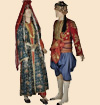 Turkey is a country with old clothing traditions. Their roots are in the Ottoman Empire which has formed Turkish cultural and traditional heritage pretty much. Even hundreds of years after the Ottoman Empire, Turkish national costume has a lot of features typical for those days. But today few people in Turkey wear traditional clothing in day-to-day life. Men usually use European style of clothes or mix some elements of the folk dress with western pieces of attire. Women wear national costumes more often, they retained the national dress more fully and keep the traditions more carefully.
Turkey is a country with old clothing traditions. Their roots are in the Ottoman Empire which has formed Turkish cultural and traditional heritage pretty much. Even hundreds of years after the Ottoman Empire, Turkish national costume has a lot of features typical for those days. But today few people in Turkey wear traditional clothing in day-to-day life. Men usually use European style of clothes or mix some elements of the folk dress with western pieces of attire. Women wear national costumes more often, they retained the national dress more fully and keep the traditions more carefully.
- Details
- Category: Turkey
- Hits: 230300
 Clothing traditions are often common for the neighboring countries. This rule almost always works for accessories. That's why conical hats are typical for many Asian countries, fez for the Middle East, cowboy hats for North and South Americas, high fur hats (called "papaha") for Caucasus, turbans for Arabian countries, the Near East and India, and berets for Europe.
Clothing traditions are often common for the neighboring countries. This rule almost always works for accessories. That's why conical hats are typical for many Asian countries, fez for the Middle East, cowboy hats for North and South Americas, high fur hats (called "papaha") for Caucasus, turbans for Arabian countries, the Near East and India, and berets for Europe.
- Details
- Category: Nationalclothing
- Hits: 16438
 Where can you try on a sombrero, hijab or war bonnet in Ukraine? For free. And make some photos, also for free. There is one place: Outlook world culture festival, which was held in May in Kyiv, Ukraine. It is an annual festival of world traditional clothing, crafts, and art. Beautiful ornated traditional costumes, national dances, cuisines of different countries and other amusing stuff.
Where can you try on a sombrero, hijab or war bonnet in Ukraine? For free. And make some photos, also for free. There is one place: Outlook world culture festival, which was held in May in Kyiv, Ukraine. It is an annual festival of world traditional clothing, crafts, and art. Beautiful ornated traditional costumes, national dances, cuisines of different countries and other amusing stuff.
- Details
- Category: Nationalclothing
- Hits: 15387
 Traditional Ukrainian headdress for unmarried girls is a wreath. It is also a headdress for a bride at her wedding. There are many different kinds of wreaths. Usually they are made of fresh flowers and herbs or dried flowers and herbs and embellished with colorful ribbons (by the way, girls used to wear ribbons of specific length at a certain age: toddlers – to the ear, little girls – shoulder blade long, teenagers – below the belt, and brides – floor-long). Sometimes fabrics, beads, feathers, metal, glass and even plastic are used. Today we are presenting you a great collection of Ukrainian national festive headgears for brides from various regions of the country. They are vintage wreaths from museums and private collections.
Traditional Ukrainian headdress for unmarried girls is a wreath. It is also a headdress for a bride at her wedding. There are many different kinds of wreaths. Usually they are made of fresh flowers and herbs or dried flowers and herbs and embellished with colorful ribbons (by the way, girls used to wear ribbons of specific length at a certain age: toddlers – to the ear, little girls – shoulder blade long, teenagers – below the belt, and brides – floor-long). Sometimes fabrics, beads, feathers, metal, glass and even plastic are used. Today we are presenting you a great collection of Ukrainian national festive headgears for brides from various regions of the country. They are vintage wreaths from museums and private collections.
- Details
- Category: Ukraine
- Hits: 25759
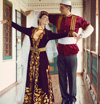 Crimean Tatars have got a very beautiful and ornated national costume. There are only about 2 millions of Crimean Tatars in the world, and about 300 thousands of them live in Ukraine. The history of this people is rather difficult and sad. But still they managed to keep all the most important traditions – language, national clothing, folklore, cuisine etc. In this article you will learn more about the traditional dress of Crimean Tatars, one of the most proud-spirited and bearing nation in Europe.
Crimean Tatars have got a very beautiful and ornated national costume. There are only about 2 millions of Crimean Tatars in the world, and about 300 thousands of them live in Ukraine. The history of this people is rather difficult and sad. But still they managed to keep all the most important traditions – language, national clothing, folklore, cuisine etc. In this article you will learn more about the traditional dress of Crimean Tatars, one of the most proud-spirited and bearing nation in Europe.
- Details
- Category: Ukraine
- Hits: 47724
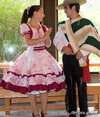 Traditional clothing of Chile is very festive and convenient at the same time. It is usually made of natural materials. Women's attire is rather feminine and men's costume is very masculine. Chilean national clothing is bright and, embellished with embroidery and colorful ribbons. The origin of the traditional costume of Chile historically is very old, but Spanish and Portuguese national clothing (which belongs to a much later time) had a great influence on the formation of Chilean traditional costume. So, today Chilean national clothing is a great mix of old natural handmade fabrics and modern style and cut.
Traditional clothing of Chile is very festive and convenient at the same time. It is usually made of natural materials. Women's attire is rather feminine and men's costume is very masculine. Chilean national clothing is bright and, embellished with embroidery and colorful ribbons. The origin of the traditional costume of Chile historically is very old, but Spanish and Portuguese national clothing (which belongs to a much later time) had a great influence on the formation of Chilean traditional costume. So, today Chilean national clothing is a great mix of old natural handmade fabrics and modern style and cut.
- Details
- Category: Chile
- Hits: 131513
 People of Somalia use their national costumes rather often. Unlike Europeans who take the traditional clothing out of the closet only for festivals and special occasions, Somalis use such garments in day-to-day life. Only in big cities people wear Western dress every day, but use traditional costumes for events and special occasions. As the climate in Somalia is hot, people cover most of the body from scorching sun and use natural materials to make clothing. They also wear loose garments (even men prefer skirt-like clothing) to prevent overheating.
People of Somalia use their national costumes rather often. Unlike Europeans who take the traditional clothing out of the closet only for festivals and special occasions, Somalis use such garments in day-to-day life. Only in big cities people wear Western dress every day, but use traditional costumes for events and special occasions. As the climate in Somalia is hot, people cover most of the body from scorching sun and use natural materials to make clothing. They also wear loose garments (even men prefer skirt-like clothing) to prevent overheating.
- Details
- Category: Somalia
- Hits: 123400
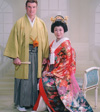 Traditional Japanese clothing is still in use in Japan. But mostly people wear the national costume for festivals, formal events, weddings, funerals and various ceremonies. In day-to-day life Japanese wear western clothing. The main pieces of Japanese traditional clothing are: hakama, kimono, fundoshi, happi, hanten, jinbei, samue, obi (sashes), sokutai, uwagi, and yukata. Japanese male national costume is not really masculine, and female attire is not very feminine. The main feature of both costumes is chastity and virtue. But the national clothing of this country is really unique and outstanding.
Traditional Japanese clothing is still in use in Japan. But mostly people wear the national costume for festivals, formal events, weddings, funerals and various ceremonies. In day-to-day life Japanese wear western clothing. The main pieces of Japanese traditional clothing are: hakama, kimono, fundoshi, happi, hanten, jinbei, samue, obi (sashes), sokutai, uwagi, and yukata. Japanese male national costume is not really masculine, and female attire is not very feminine. The main feature of both costumes is chastity and virtue. But the national clothing of this country is really unique and outstanding.
- Details
- Category: Japan
- Hits: 75539
 Peruvians are excellent craftsmen. Their clothing is still homemade in XXI century and looks pretty much like traditional garments used centuries ago. People of Peru wear ponchos, dresses, blankets, sweaters, layered skirts, tunics, sombreros, chullos and other native pieces of clothing. The national costume of Peru is very colorful and bright, it is beautiful and original although the clothes are rather thick and worm.
Peruvians are excellent craftsmen. Their clothing is still homemade in XXI century and looks pretty much like traditional garments used centuries ago. People of Peru wear ponchos, dresses, blankets, sweaters, layered skirts, tunics, sombreros, chullos and other native pieces of clothing. The national costume of Peru is very colorful and bright, it is beautiful and original although the clothes are rather thick and worm.
- Details
- Category: Peru
- Hits: 118315
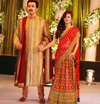 The clothing traditions in India were formed by the influence of local climate, beliefs, cultural traditions and different regional peculiarities. People of India wear ornated attires made from natural fabrics. They use a lot of jewelry and embellishment. Very often Indian garments consist of a simple large piece of cloth that can be draped in various ways. The national Indian female clothing is rather modest and feminine at the same time. That's why it is popular not only in India but in many other countries of the world.
The clothing traditions in India were formed by the influence of local climate, beliefs, cultural traditions and different regional peculiarities. People of India wear ornated attires made from natural fabrics. They use a lot of jewelry and embellishment. Very often Indian garments consist of a simple large piece of cloth that can be draped in various ways. The national Indian female clothing is rather modest and feminine at the same time. That's why it is popular not only in India but in many other countries of the world.
- Details
- Category: India
- Hits: 37443
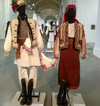 The most interesting collection of Ukrainian men's and women's festive garments was presented in Ukraine. It shows the traditional clothing of different regions of the country with all peculiarities and details. Every costume was gleaned by all the canons of use. Every attire looks just as it should and did in real life in 19-20th centuries. We offer you to see the samples of Ukrainian festive clothing of various regions on photos below.
The most interesting collection of Ukrainian men's and women's festive garments was presented in Ukraine. It shows the traditional clothing of different regions of the country with all peculiarities and details. Every costume was gleaned by all the canons of use. Every attire looks just as it should and did in real life in 19-20th centuries. We offer you to see the samples of Ukrainian festive clothing of various regions on photos below.
- Details
- Category: Ukraine
- Hits: 24755
 The Federal Republic of Nigeria is a not very large, though rather populous country of West Africa. About 150 million of people live in Nigeria. So, the clothing traditions of its population are various. Some of the traditional dresses in Nigeria root back to ancients tribes who lived here centuries ago, others were formed by the influence of British, Portuguese and French colonizers (19-20th centuries). Today many people in Nigeria use modern clothes, western style of attire. But still there are a lot of Nigerians who prefer to wear the traditional dress of Nigeria in everyday life.
The Federal Republic of Nigeria is a not very large, though rather populous country of West Africa. About 150 million of people live in Nigeria. So, the clothing traditions of its population are various. Some of the traditional dresses in Nigeria root back to ancients tribes who lived here centuries ago, others were formed by the influence of British, Portuguese and French colonizers (19-20th centuries). Today many people in Nigeria use modern clothes, western style of attire. But still there are a lot of Nigerians who prefer to wear the traditional dress of Nigeria in everyday life.
- Details
- Category: Nigeria
- Hits: 138860
Page 68 of 70
